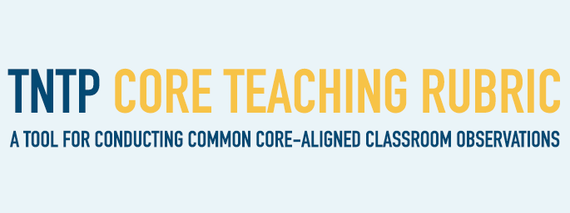By Tim Daly
From all the attention on teacher evaluation that focuses specifically on the use of student test results, you might think the other components work just fine.
But that’s the opposite of the truth. In fact, for many schools, the most traditional approach to evaluating teacher performance is in the worst shape. Classroom observations are a mess.
Observations are our most consistent opportunity to offer teachers immediate feedback, and their results account for the lion’s share of most performance ratings. Yet, as we wrote in a recent whitepaper called Fixing Classroom Observations, observations are often failing to meet their basic stated goals of giving formative feedback and producing accurate readings of performance.
By far, the most important reason is the need for better training and support for observers, along with accountability for school leaders doing the critical work of evaluating and developing their staffs.
But there’s another important reason: overstuffed, clumsy rubrics.
We’ve been hard at work to develop a better alternative. After several months of prototyping and road testing, we’re proud to announce the release of the TNTP Core Teaching Rubric.
Better tools won’t make up for lack of training, support or accountability, but rubrics that are difficult to use and lack focus on essential elements of instruction will hold educators back. Strong tools are even more important as schools implement new Common Core State Standards.
TNTP Core is a departure from many rubrics in use today (including some that we helped design). It is shorter and easier to use—the full version is just four pages long. And it puts an explicit focus on essential content, which was always important but has become even more so with Common Core.
TNTP Core prompts observers to focus on just four basic questions about what’s happening in a classroom (and what isn’t):
1. Are all students engaged in the work of the lesson from start to finish?
2. Are all students working with essential content for their subject and grade?
3. Are all students responsible for doing the thinking in this classroom?
4. Do all students demonstrate that they are learning?
Best of all, TNTP Core is free to anyone who wants to use it, under a Creative Commons license.
Why free? Because we want educators to use and improve it. Rubric design is not a one-time thing. In fact, we’ve already fine-tuned our rubric based on feedback we got from volunteers who tested it out at schools across the country. By taking this open-source approach, we hope schools can pilot it, tweak it, and pilot it some more.
Our rubric is different in other ways, too. Usually, rubrics start by codifying teacher actions that are understood by rubric authors to be good practice, and prompt observers to watch the adult in the room to look for them. The TNTP Core Teaching Rubric instead puts the focus on what students are doing, and prompts observers to look for signs that they’re working on the right challenges and meeting those challenges. Great teaching doesn’t necessarily always look the same; you’ve got to look at what students are learning to make sure you’ve found it. With this approach, we hope to remove the pedagogical straightjacket from observations.
That focus can help address a second challenge: assessing implementation of the Common Core. Most rubrics have a very cursory treatment of lesson content, focusing only on lesson objectives—so for example, it’s possible for a teacher to earn high marks for “effective instruction” for a lesson presenting sixth-grade material to a high-school geometry class that should be doing something far more challenging. In our rubric, “Essential Content” is one of the four performance areas scored during each observation. Rather than a yes/no check for a lesson objective, observers are pushed to compare what students are doing to what the relevant academic standards call for.
Please take the rubric for a test drive. Download it, and take it into a classroom and use it to assess some lessons.
Then, modify it. Hack it. And let us know what you learn.
Tim Daly is President at TNTP.
This post was originally published on the TNTP Blog.
